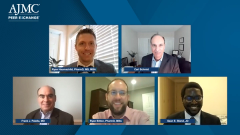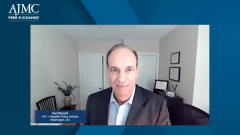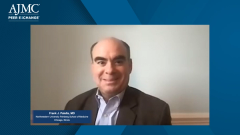
Key Takeaways for the Management of HIV PrEP
A panel of experts share closing thoughts and advice for the management and uptake of HIV PrEP therapy.
Episodes in this series

Ryan Haumschild, PharmD, MS, MBA: Before we conclude, I want to get final thoughts from each of you. Because each of you provided so much great content. But if you had to boil it down and leave our payors, or providers, or pharmacy team members that are tuning in to this peer exchange with 1 great piece of advice or 1 conclusion statement, I want you to think about what that would be. And Frank, I’m probably going to start with you to lead us off with your one kind of conclusion or final thought based on this peer exchange around PrEP [pre-exposure prophylaxis] therapy.
Frank J. Palella, MD: There are currently 1.2 million persons infected with HIV in this country, and at least as many at risk. There are on average 30,000 to 40,000 new infections per year. Through rapid start tests and treat strategies, we can avoid maybe two-thirds of those new infections but clearly not 100 of them. The rest of the remainder of avoidance of new infections must be accomplished through the routine utilization of PrEP by individuals at greatest risk for HIV acquisition. This can only be accomplished through awareness, education, identification of persons who are at risk and systematic availability of PrEP therapy for them, not just initiation of PrEP, but continuance and maintenance in PrEP care. And this requires collaboration of health care providers, of third party payors of persons who understand social determinants of health and can deal with the disparities that are in place in our society and for medical care. Advocacy is needed, we are much further than we were 5 years ago. We’ve got a long way to go.
Ryan Haumschild, PharmD, MS, MBA: Great thoughts. Partnership, keeping up with therapy beyond the initial prescription, such key takeaways in your final thought. I appreciate that. Sean, I want to look to you. You’ve provided such great information. But I can tell when I asked you for further improvements and opportunities, you still have a long list. What’s your final thought for our audience today?
Sean E. Bland, JD: The main thought is it’s going to take all of us. It’s going to take community stakeholders, it’s going to take providers, it’s going to take health plans, it’s going to take folks who are working in government and other partners to really expand PrEP access, and then make sure that we are working to end the HIV epidemic across the U.S. It’s going to be the main focus. And making sure that that happens, we need a holistic approach. An approach, that again, addresses the social determinants of health, as well as making sure that we’re not just centering around HIV. We’re centering the holistic experiences of individuals. That includes talking about what PrEP means to individuals. What does it mean for their sexual health? What does it mean for their ability to experience pleasure? Making sure that that’s part of the conversation as well. And in doing all of this, making sure that we are centering health equity and making sure that we’re having advocacy that is hearing from and being led by the communities that are most impacted by HIV.
Ryan Haumschild, PharmD, MS, MBA: I love that community buy-in. That is truly how you move forward. It’s getting people bought into that process. And that’s huge, especially, when right now we have that burning platform around health equity. How do we take advantage of that? Thank you so much for that comment. Ryan, I’m going to look to you as a payor. You’re essential to this process. You play a huge role in determining coverage, helping facilitate claims, and also oversight of these patients and improving the public health. What is your final thought that you want our viewers to know from that payor and health plan perspective?
Ryan Bitton, PharmD, MBA: I’ve enjoyed the conversation. There’s a lot of passion and the 1 takeaway that resonates with me is that there’s still a lot of unmet needs. We’re not done. Just because we have better therapies than we had before doesn’t mean that we figure this out. And there’s still a lot of work to do. And from the payor perspective, one of the things that’s been itching in my mind as we’ve talked about this is the power of data. And the fact that adherence and COVID-19 we’ve seen drop offs in some of the utilization here. Heading in the wrong direction is probably because of the COVID-19. The data that we have from a payor perspective could help say, hey, these folks are hearing. These people maybe struggling with their adherence with their treatments. Working together as an opportunity to partner with our local providers and our local patients. And having these local processes, the community of support to make sure that we’ve got success.
Ryan Haumschild, PharmD, MS, MBA: Data is to targeted interventions, I completely agree with you. It’s a great takeaway. And honestly, how payors that have the data can help leverage that to create change. And Carl, we’re going to finish with your final thoughts. Obviously, you have a lot going on from advocacy, that work that you’re doing, work that you’re pushing forward in new bills. What’s your final thought for our audience?
Carl Schmid: This has been a great conversation. And it shows that we need the collaboration of all partners. And with the leadership of our government to implement the current PrEP technologies in the guidance in the laws. But we still have a long way to go and the future is bright. We have new opportunities, there’s going to be new PrEP approved very soon. And it’s going to bring on additional complexities. And we’re going to have to go through another U.S. Preventive Services Task Force review. We’ve already started that process. And then we’ll probably have to get more guidance coming out of the federal government on how it should be implemented. And we still need a national PrEP program. And as I mentioned, we need to have that government leadership. I am excited about the future. We still have to get through and implement what we have now. But there’s going to be a lot more to implement and to navigate in the future.
Ryan Haumschild, PharmD, MS, MBA: Thank you to my expert panel, again, for just all of your insights, all of your knowledge, and all of your willingness to share, and passion can’t forget that—Ryan called that out. And I also want to thank our viewing audience for tuning in today. Looking at takeaways from a provider, a payor, an advocacy perspective, and policy. And what we can do to keep improving the care for these patients specifically around PrEP therapy. We hope that you found this AJMC® Peer Exchange discussion to be useful and informative. And hopefully you have some key takeaways that you can utilize in your personal practice, whether it be a payor or health care provider. Thank you all for tuning in. And please be on the lookout for your next peer exchange.
Transcript Edited for Clarity
Newsletter
Stay ahead of policy, cost, and value—subscribe to AJMC for expert insights at the intersection of clinical care and health economics.








































